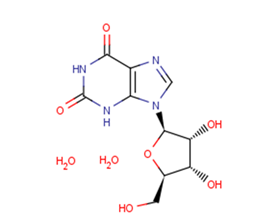
Xanthosine dihydrate
CAS No. 5968-90-1
Xanthosine dihydrate( —— )
Catalog No. M19863 CAS No. 5968-90-1
Xanthosine is produced by guanine-free mutants of bacteria e.g. Bacillus subtilis Aerobacter aerogenes. Xanthosine monophosphate is an intermediate in purine metabolism formed from IMP and forming GMP.
Purity : >98% (HPLC)
 COA
COA
 Datasheet
Datasheet
 HNMR
HNMR
 HPLC
HPLC
 MSDS
MSDS
 Handing Instructions
Handing Instructions
| Size | Price / USD | Stock | Quantity |
| 5MG | 48 | In Stock |


|
| 10MG | 68 | In Stock |


|
| 25MG | 115 | In Stock |


|
| 50MG | 173 | In Stock |


|
| 100MG | 258 | In Stock |


|
| 200MG | 388 | In Stock |


|
| 500MG | 642 | In Stock |


|
| 1G | Get Quote | In Stock |


|
Biological Information
-
Product NameXanthosine dihydrate
-
NoteResearch use only, not for human use.
-
Brief DescriptionXanthosine is produced by guanine-free mutants of bacteria e.g. Bacillus subtilis Aerobacter aerogenes. Xanthosine monophosphate is an intermediate in purine metabolism formed from IMP and forming GMP.
-
DescriptionXanthosine is produced by guanine-free mutants of bacteria e.g. Bacillus subtilis Aerobacter aerogenes. Xanthosine monophosphate is an intermediate in purine metabolism formed from IMP and forming GMP.
-
In Vitro——
-
In Vivo——
-
Synonyms——
-
PathwayOthers
-
TargetOther Targets
-
RecptorOthers
-
Research Area——
-
Indication——
Chemical Information
-
CAS Number5968-90-1
-
Formula Weight320.26
-
Molecular FormulaC10H16N4O8
-
Purity>98% (HPLC)
-
SolubilityDMSO:10 mM
-
SMILESO.O.OC[C@H]1O[C@H]([C@H](O)[C@@H]1O)n1cnc2c1[nH]c(=O)[nH]c2=O
-
Chemical Name——
Shipping & Storage Information
-
Storage(-20℃)
-
ShippingWith Ice Pack
-
Stability≥ 2 years
Reference
molnova catalog



related products
-
Gastrin Releasing Pe...
Gastrin Releasing Peptide (1-16), human
-
Fibronectin Active F...
Fibronectin is a high-molecular weight (~440kDa) extracellular matrix glycoprotein that binds to membrane-spanning receptor proteins called integrins.In addition to integrins, fibronectin also binds extracellular matrix components such as collagen, fibrin and heparan sulfate proteoglycans.
-
EML4-ALK kinase inhi...
EML4-ALK kinase inhibitor 1 is a potent oral active inhibitor of echinoderm microtubule-associated protein-like 4-anaplastic lymphoma kinase (EML4-ALK), with an IC50 of 1 nM.



 Cart
Cart
 sales@molnova.com
sales@molnova.com


